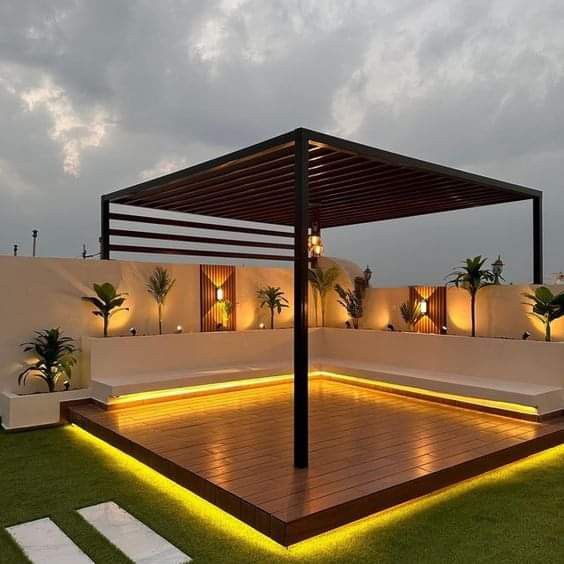The Ultimate Guide to Selecting a Pergola for Your Terrace
PERGOLA & GAZEBO


Understanding the Purpose of a Pergola
Homeowners select pergolas for their terraces for a multitude of reasons, primarily due to their multifunctional nature. One of the most significant benefits of a pergola is the provision of shade. By strategically placing a pergola over a seating area or dining space, homeowners can enjoy their outdoor spaces even during peak sun hours, making it a desirable location for relaxation. Additionally, with the right choice of materials and design, a pergola can create a cool, shaded retreat that encourages outdoor living.
Beyond functionality, pergolas enhance the overall aesthetics of a terrace. They serve as architectural elements that can elevate the visual appeal of a home’s exterior while harmonizing with the surrounding landscape. Different designs, from traditional to modern, allow homeowners to personalize their spaces, reflecting their style and preferences. When coupled with climbing plants or decorative lights, a pergola can create an inviting ambiance that draws residents and guests alike to an outdoor setting.
Furthermore, a pergola can define spatial boundaries within an outdoor environment. This modular structure allows homeowners to create distinct areas for various activities, such as dining, lounging, or gardening, effectively optimizing the layout of their terrace. This delineation not only contributes to functionality but also promotes a sense of organization in the outdoor space.
Installing a pergola can also increase property value. As an attractive feature that enhances usability and aesthetic appeal, a well-crafted pergola is often viewed favorably by potential buyers. Finally, it serves as a bridge between indoor and outdoor living spaces, offering new opportunities for relaxation and entertainment, making the terrace a focal point for gatherings. Such enhanced utility and design make a pergola a worthwhile investment for any homeowner looking to enrich their outdoor experience.
Factors to Consider When Choosing a Pergola
When selecting a pergola for your terrace, several key factors must be evaluated to ensure the structure meets both aesthetic and functional needs. First and foremost, consider the size and layout of your terrace. The dimensions of the pergola should complement the available space without overwhelming or underwhelming the area. Take careful measurements and visualize the pergola's placement to achieve a balanced and harmonious look.
Next, the choice of material is essential. Pergolas can be constructed from various materials such as wood, metal, or vinyl. Each option has distinct advantages and drawbacks. Wooden pergolas offer a classic, natural elegance but may require regular maintenance to prevent rot and weathering. Metal structures are often more durable and resistant to harsh weather, but they can be subject to rust unless properly treated. Vinyl pergolas provide a low-maintenance alternative that resists decay and offers a variety of finishes, though they may lack the timeless appearance of wood.
Style compatibility with the existing home architecture is another crucial consideration. The chosen pergola should enhance the overall aesthetic of your home rather than clash with its design. Whether your residence is modern, traditional, or somewhere in between, select a pergola that complements its architecture to create a seamless look.
Climate considerations are vital when choosing a pergola. The local climate will influence the materials used and the design aspects, such as the amount of shade provided and whether the structure will shelter against wind or rain. Additionally, budgets play a significant role when selecting a pergola. Weigh the initial costs against long-term durability and maintenance requirements to ensure you invest wisely in a structure that will serve you well for years to come.
Design Options for Your Pergola
When designing your pergola, one of the most crucial aspects to consider is the aesthetic appeal it brings to your terrace. Pergolas come in a multitude of styles, ranging from traditional to contemporary, allowing homeowners to select a design that complements their outdoor living space. A traditional pergola often features sturdy wooden beams and a simple lattice roof, providing an inviting atmosphere that works well with both gardens and patios. For those who prefer a modern take, options such as sleek metal structures or minimalist designs can lend a sophisticated touch to your terrace.
Another significant design consideration is the type of roof you choose for your pergola. Flat roofs offer a clean, streamlined look, ideal for modern architectural styles. On the other hand, pitched roofs can add dimension and character, enhancing the overall visual interest of your space. Arched roofs create an elegant curve, adding a soft touch that pairs beautifully with climbing plants and vines. These roof options not only contribute to aesthetics but also affect the level of shade provided, influencing overall comfort during sunny days.
Incorporating additional features into your pergola design can elevate both functionality and beauty. Curtains can provide privacy and protection from the elements, transforming your pergola into a cozy retreat. Louvered roofs allow you to adjust airflow and sunlight exposure, making it easier to adapt to changing weather conditions. Finally, consider the integration of climbing plants, which can soften the structure and enhance the natural ambiance of your terrace. Using graphics or photos of various design ideas can serve as a valuable source of inspiration, allowing you to visualize how these elements can come together to create your perfect outdoor getaway.
Installation and Maintenance Tips
When it comes to installing a pergola on your terrace, several factors need to be taken into consideration. First and foremost is the level of your DIY skills. While many are tempted to undertake this project themselves for the sake of cost-effectiveness, it is crucial to assess whether you have the necessary tools and experience. If you are comfortable with carpentry or metalwork, and possess the appropriate tools, a DIY installation can be both rewarding and economical. However, if you are unsure of your abilities, hiring a professional installer may save time and ensure the structure's integrity.
Before starting the installation, you should carefully plan the layout of the pergola, including measurements and potential location impacts, such as sunlight and shade. Securing the necessary permits is also prudent, as some regions have specific regulations regarding the construction of outdoor structures. Furthermore, consider the site conditions; stable, level ground is essential for the durability of the pergola.
Maintenance is equally important to prolong the lifespan of your pergola. Regular cleaning should be part of your maintenance routine. Use mild soap and water to clean the surfaces, especially if they accumulate dirt or debris. Additionally, it's advisable to perform seasonal inspections to check for signs of wear and tear, such as loose fittings or weather-related damage.
If your pergola is made of wood, applying a protective sealant every few years can prevent water damage and decay. For metal structures, use rust-inhibiting paint to protect against corrosion. By following these installation and maintenance tips, you can ensure that your pergola remains a beautiful and functional feature of your terrace for many years to come.


